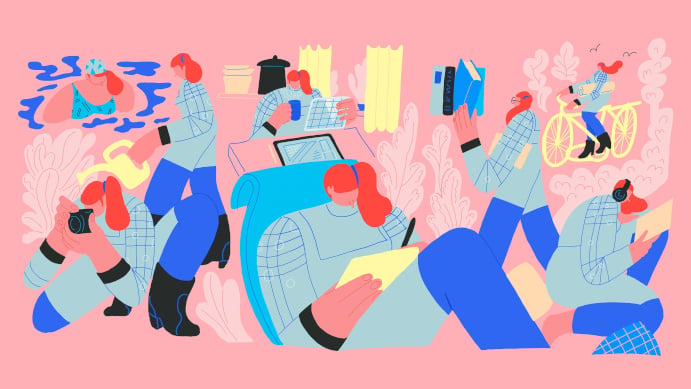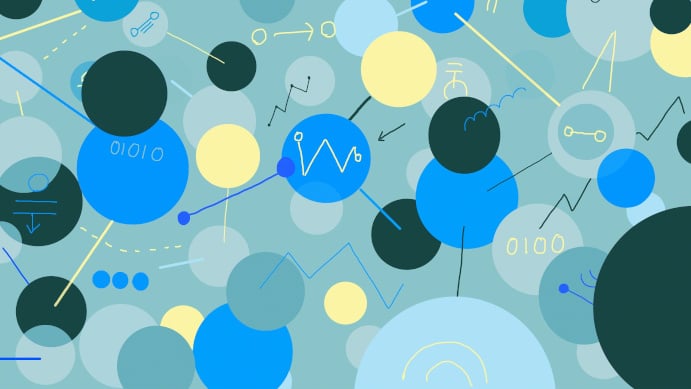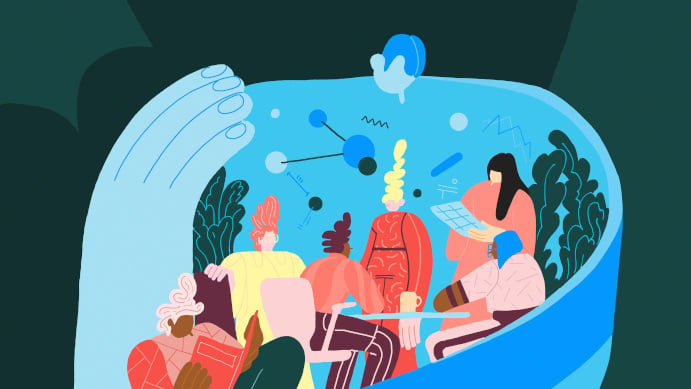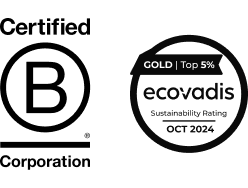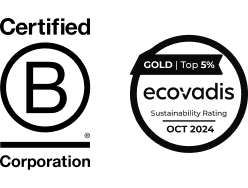How artificial intelligence, smart data and the gig economy will transform the future of work.
In the future, all companies will be tech companies, and your office will look astoundingly different. We invite you to look at what lies ahead:

It’s rather incredible to consider the first iPhone was sold in 2007, a little more than ten years ago. The work you do has probably changed quite a bit since then—where and when you read your emails, how you contact colleagues, what social media sites you browse to keep tabs on your company’s latest products and initiatives, maybe even the artificial intelligence-curated playlist you listen to as you work through a presentation or expense report.
In another 10 years, the integration of artificial intelligence, virtual reality and human analytics will make your current office look as quaint and unrecognisable to you as the rotary phone that once hung from your kitchen wall. In the future, you may walk about an office full of computers, but these computers will look and feel profoundly different: VR headsets will still create immersive holographic experiences, but more people will choose chic, less isolating augmented reality glasses that layer virtual information atop the physical plane. Rooms and furnishings will feel different, more intuitive and comfortable, designed to accommodate diverse networks of writers, programmers, designers and scientists who come together to solve difficult problems.
Perhaps the most noticeable change will be that the lines between technology and space will blur. Embedded with smart sensors and speech recognition software, your workplace will take care of much of the administrative day-to-day: transcribing meeting notes, scheduling conference calls, responding to routine emails and generally serving as a dutiful member of your team. Open, naturally lit spaces designed for your wellbeing will accommodate the varied work styles, privacy expectations and personality types of the teams that occupy them. Your office will feel more like a person, a colleague or life coach, who guides you toward your best self, or at least your best working self.
At Steelcase, we are keenly interested in how these and other plausible scenarios will affect the future of work, workers and the workplace.
At Steelcase, we are keenly interested in how these and other plausible scenarios will affect the future of work, workers and the workplace. Our Foresight Practice, modelled after a design thinking process developed by the Institute for the Future, the world’s leading nonprofit strategic futures organisation, carefully analyses and forecasts how signals of change observed in the marketplace today will frame future states. These predictive scenarios inform product development and manufacturing decisions that conceptualise and create the future. We’ve developed this practice as part of our culture of design thinking: deeply understanding the lives of people at work, as we continually work to improve the employee experience.
The edges of the future are visible today. We see its first blush in the growing number of workplaces providing flexible workstations—whether they are collaborative lounges, treadmills, bikes or adjustable-height sit-stand desks—to give workers a break from sitting, reduce fatigue and stiffness, and boost productivity. We recognise its beacon in a young Palo Alto analytics firm using microphones and sensors, along with email and calendar data, to track employee activity levels, time spent multitasking, and how often associates are in touch with key contacts. We smile at its gleam in the biophilic wood panelled walls and Circadian light arrays of retail stores—the bicycle stalls and changing stations that have become standard features of modern offices. These examples represent a small fraction of the ways today’s companies are adapting spaces to align with human needs and the constantly changing workplace demands.
Tomorrow, organisations will be able to manage buildings, desks and computers as never before, supporting employees by giving them greater control over their environments. The data and AI brokered to orchestrate these changes will teach machines to anticipate and predict desired future states—to go beyond sensing and responsiveness to speak to us intimately, assist with our projects and tasks, and improve our workplace performance, productivity and wellbeing.
In the future, all companies will be tech companies, and your office will look astoundingly different. We invite you to look at what lies ahead:
Glimpses Into the Future
- Active Agents in the Gig Economy
- Navigating Oceans of Data
- Intelligent Innovation Networks
- Healthy, Sustaining Spaces
- Room as Team Member
- Spaces that Know Us
- Virtual Social Spaces
Active Agents in the Gig Economy
Freelancers already make up 35 percent of U.S. workers, according to a survey released by the Freelancers Union, based in New York City. Another large study released by the McKinsey Global Institute found that 20-30 percent of the labour force in the European Union is made up of independent workers who are self-employed or do temporary work. As the gig economy expands, freelancers and salaried professionals will look for greater diversity in their work experiences and new roles that inspire and challenge them. Companies of all sizes will follow suit as the workforce fluctuates, experimenting with flexible office arrangements, modular workplaces, co-working spaces and new service models for using and provisioning space.
Consider this scenario in the not-so-distant future: Your company pays a monthly membership fee for a flexible workplace in San Francisco’s Little Saigon to support its rapidly growing teams with the kind of spaces that fit your culture. You spend much of the first quarter in this custom-built office suite, looking out at a newly-revitalised city park as you sip your fruit water. There is not a PC to be found. What you see, instead, are touchscreen computers for small or large groups—some fixed, some mobile—in open studios. You meet a freelance data analyst from Senegal, who moonlights as a Lyft driver, a tech writer whose byline you remember vaguely from Wired, and a PhD. candidate attending Cambridge, who specialises in “topic modelling,” an algorithm used to categorise written text into substantively meaningful categories.
You review the terms of a two-week project in an informal space, where softly upholstered chairs, richly grained oak tables and plush rugs make everyone a bit more comfortable and relaxed. Two weeks later the data analyst is off to New Jersey for a consulting job in population healthcare, but you’re connected on Upwork and he’s easy enough to reach online. One early morning in April you work from home, getting dressed in a suit and tie and slipping on a mixed reality headset to present a detailed project pitch to a potential client in London whose day is halfway through. Their hologram-like images appear, as if by magic, in a virtual boardroom. The PhD. candidate is there, too—or at least her incredibly lifelike image is— ready with an impressive word visualisation, clarifying past customers’ perceptions of the potential client. You enjoy shifting between work at the new office and your home, feeling free to choose the places that best support the work you need to do.
Glimpses Into the Future
- Active Agents in the Gig Economy
- Navigating Oceans of Data
- Intelligent Innovation Networks
- Healthy, Sustaining Spaces
- Room as Team Member
- Spaces that Know Us
- Virtual Social Spaces
Navigating Oceans of Data
We’re already inundated by massive amounts of information bombarding us from seemingly every direction. And yet we will see more, more and more data being effortlessly collected by growing numbers of sensors and machines. How will we make sense of it all? The rapid growth of machine learning and artificial intelligence systems will move from being a far-away scenario to an everyday necessity as we increasingly rely on these backstage systems to analyze and apply data in meaningful ways to our work and lives. New forms of interaction with data will also emerge; in fact, many predict that AR and VR will become a primary mode of interacting with large data sets in new, visual and immersive forms. “Data” will no longer be 2D strings of information on a blinking screen; it will become embodied through immersive experiences that are powered by AI.
The primary advantage of this format over a typical computer interface is that displays will no longer be tethered to walls or flat surfaces. A virtual tree will be experienced, in three dimensions, just as a tree in the physical world. Since worlds have height, depth, width and distance, where information is hosted will matter. Digital spatial coordinates will map where content is placed in the virtual world, a representational analog of our own. Associations with places in our world will help us locate apps, programs and tools in the virtual world.
If you’ve ever tried to review a giant spreadsheet or book-length manuscript, while scrolling in and out of 10 open Internet tabs on your desktop, you understand the desire to develop such new interfaces. Imagine a future in which you can turn around in a circle and engage with only the data you need, reach out and touch it across three dimensions. This will radically change how information is displayed and manipulated in space. Flat screens and browser windows will become obsolete. We will explore volumetric visualisations of data worlds with broad gestures of our head, arms and bodies. Chairs and other furnishings will operate like joysticks, leveraging our actual body motions to change our physical orientation in virtual space. Numbers will become almost-physical objects that we can, quite literally, play with.
Imagine a future in which you can turn around in a circle and engage with only the data you need, reach out and touch it across three dimensions.
Glimpses Into the Future
- Active Agents in the Gig Economy
- Navigating Oceans of Data
- Intelligent Innovation Networks
- Healthy, Sustaining Spaces
- Room as Team Member
- Spaces that Know Us
- Virtual Social Spaces
Intelligent Innovation Networks
As open platforms and digital networks grow, organisations will be pressed to evolve more rapidly, with greater precision and with increased participation from experts in the world at large. Signals of this change are already underway, transforming healthcare. Take, for instance, the development of The Cancer Genome Atlas, where researchers from institutions across the country are working collaboratively to catalogue all of the changes to DNA and molecules in more than 30 different cancer types. Or the development of OpenMRS, an electronic medical records platform bringing increased care coordination to parts of the developing world where it is needed to treat populations afflicted with AIDS, malaria and tuberculosis.
Consider how your office might evolve in a deeply connected, networked space of augmented human interaction in which 100 people contribute 10 minutes of work to a project—a scenario predicted by the Finnish sociologist Esko Kilpi. Spaces will need the flexibility to accommodate fluid teams and complex workflows, while ensuring transparency and access to information across vast networks. In the morning, you’ll work in a private space enclosed in glass that allows for concentrated solitary work but emphasises a feeling of transparency. Later in the day, you’ll talk to colleagues in Dubai and Berlin in a video-connected conference room where speech recognition and translation software allow you to hear them crystal clear in your native tongue. Large touchscreen monitors that allow for the manual manipulation of apps and programs will invite participation from everyone in the room, and for those who are feeling a bit sluggish in the late afternoon, a condensed synopsis and to-do list will be stored in the cloud, thanks to AI-informed office furnishings.
Glimpses Into the Future
- Active Agents in the Gig Economy
- Navigating Oceans of Data
- Intelligent Innovation Networks
- Healthy, Sustaining Spaces
- Room as Team Member
- Spaces that Know Us
- Virtual Social Spaces
Healthy, Sustaining Spaces
Designing the workplace to support wellbeing is a recent focus of organisational behaviour models and architectural practice. However, the intensification of work that comes with digital transformation means people will need new ways to maintain not only their physical wellbeing, but also to do their best thinking and feel an emotional connection to their work. Green walls to filter air, sleep pods and sensors to count employee’s stair steps are already a reality in some workplaces.
As businesses plan for a more mobile workforce and increasingly rapid cycles of change, dedicated floors and wings for “resident employees” will give way to elastic concepts that invite change. Furniture will be light, mobile and modular. A diversity of bespoke products and materials—shade lamps, handsomely upholstered sofas, stools, hardwood tables—will make the workplace feel more like home. Your desk, if you choose one, will move according to the needs of a project cycle or team assignment. To assist with creative thinking, it may recline into recumbent positions associated with deep thought. To help your body get the exercise it needs to produce endorphins and burn cortisol, it may have pedals like a stationary bicycle. You’ll see bright graphic murals and living walls of moss and succulents. Your back will feel better because you’ll be standing, sitting, perching or moving for the better part of the day. You’ll get more work done and feel better.
Glimpses Into the Future
- Active Agents in the Gig Economy
- Navigating Oceans of Data
- Intelligent Innovation Networks
- Healthy, Sustaining Spaces
- Room as Team Member
- Spaces that Know Us
- Virtual Social Spaces
Room as Team Member
If you can imagine space as a participant on your team, you may be curious as to how that spatial persona will interact with you and your colleagues. At the far edge of this frontier, we can envision the development of environmental systems that operate like friendlier, more benevolent versions of Hal 9000 from Stanley Kubrick’s classic “2001: A Space Odyssey”: artificial intelligence platforms that, while not sentient and emotionally developed in a human sense, can detect our moods and impulses with facial-and-speech-recognition software and brain-reading devices. When we’re losing energy and drifting off in a meeting, they nudge us to get a drink or eat a sandwich and refresh ourselves.
In the immediate future, we see the growing popularity of digital personal assistants, such as Cortana and Google Assistant, and smart furnishings, in the workplace. Imagine a conference table equipped with microphone arrays and speech-processing software, which comprehend and summarise conversations happening around it. Through such integrated, intelligent systems linked to the cloud, a room will be able to anticipate the needs of the team within it—bringing up past documents or project logs, for instance, or encouraging equal participation by nudging quiet team members to share their opinions.

Privacy standards will need to evolve, of course. As rooms begin to listen to us and data becomes easier to harvest, the security and privacy of employee information will become the concern of every organisation. Europe recently has taken the lead in digital privacy by establishing the General Data Protection Regulation (GDPR), which lays out sweeping individual rights over your personal data. Controlling digital stimulation by providing places for privacy, rest and rejuvenation in the physical workplace also will become increasingly important.
Many open questions remain, but what can be said is that the age of robots has arrived. Bots, virtual assistants and other software agents will act as human proxies, not only querying data but asking questions and accomplishing tasks. Space will become intelligent and conversant. Where’s that year-end report? “Right here,” the tech-embedded room will say. “I’m happy to walk you through it if you’d like.”
Glimpses Into the Future
- Active Agents in the Gig Economy
- Navigating Oceans of Data
- Intelligent Innovation Networks
- Healthy, Sustaining Spaces
- Room as Team Member
- Spaces that Know Us
- Virtual Social Spaces
Spaces that Know Us
Brain science is rapidly advancing to detect and influence our physiological and psychological states. The science is evident in a host of human performance apps and multi-sensory environments that employ selective stimuli—from the visual cues of a beehive to the rhythmic tempo of a musical composition—to frame the state of our feelings, attention, memories and moods.
With this new level of detection and analysis, environments hold the potential to enhance human performance by coming to know us intimately. Rooms will become personalised to our software habits and preferences, knowing which platforms, news feeds and applications we gravitate toward. In the same way a FitBit tells us how many calories we’ve burned and hours we’ve slept, augmented rooms and surfaces will track our behaviours through data pulled from our devices and bio-informed sensors — adjusting lighting, visual privacy, acoustics and temperature with algorithms conceived according to our personal preferences.
Bots, virtual assistants and other software agents will act as human proxies, not only querying data, but asking questions.
Over time, the design of intelligent rooms and user inter- faces will become more humanistic and intuitive, articulated in architecture and furnishings reflecting a range of postures, work modes, light levels and acoustic qualities. The introvert may find she does her best work in a private, solitary room encased in soundproof glass. The extrovert may prefer to prepare to do his year-end report in a heavily trafficked café, while listening to The Beatles. Both will come to see spaces as a partner in the generative process.
But innovations in bio-sensing technologies and artificial intelligence will do more than predict our personal preferences and desires; these augmented spaces will learn things about us, how sensory stimuli affect our habits and behaviours. As we gain a deeper understanding of how spaces affect our neural pathways and cognitive and emotional states, we’ll be able to translate these ideas more fully into architectural practice. A multi-modal mediated work environment known as Mediated Atmospheres now being studied at MIT’s Media Lab suggests the direction we’re moving: a kind of “consciousness hacking,” in which intentionally designed offices with abundant natural light, distant views and pleasing acoustics inspire clear thinking and creativity. It’s not far away, a future in which spaces prime us for behaviours and states of mind that improve performance.
Glimpses Into the Future
- Active Agents in the Gig Economy
- Navigating Oceans of Data
- Intelligent Innovation Networks
- Healthy, Sustaining Spaces
- Room as Team Member
- Spaces that Know Us
- Virtual Social Spaces
Virtual Social Spaces

Perhaps you’ll recognise this familiar, if less than perfect, scenario. You’re teleconferencing with your friend whom you haven’t seen in years and who lives halfway around the world. His face looks a bit tired, tilted at a strange angle. The better part of you knows it’s a pleasure just to be able to talk to him and see his face. Decades ago you wouldn’t have had this luxury. But the voice in your other ear is less tolerant, dissatisfied with the way this interaction, like many interactions across distance, are mediated by technology. Today’s connective “thin-media” (bits of content we consume on devices like a smartwatch, without opening our phone or computer, such as a notification) may attempt to draw us closer, but this closeness often seems fractured and incomplete.
You’ll be able to stand shoulder to shoulder with colleagues in Rotterdam, Shanghai and Mumbai at an augmented reality whiteboard, moving about and speaking to others in the room as though they were in your office.
But we believe recent technology is poised to re-frame these interactions and build trust in the future through highly immersive and visual experiences. You’ll be able to stand shoulder to shoulder with colleagues in Rotterdam, Shanghai and Mumbai at an augmented reality whiteboard, moving about and speaking to others in the room as though they were in your office. Distributed global teams are not going away, but the frustrating aspect of your interactions with these teams—the presence disparity created by a two-dimensional screen, ambient noise and distracted colleagues—will wane as meetings are held on equally experienced, common ground. What will be preserved is a diversity of geographic and cultural viewpoints that inform strategic decision making and enrich the character of the workplace.
Telepresence holds us frozen to the camera and keyboard, much like being seated behind a steering wheel in a car. Now imagine a walk through a park, or a game night with your colleagues—our physical freedom will extend by orders of magnitude: from seated to standing to moving, as well as all the postures in between.
Get ready to say farewell to presence disparity. The future of space has arrived.




